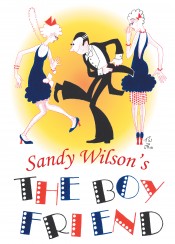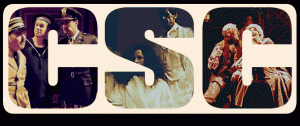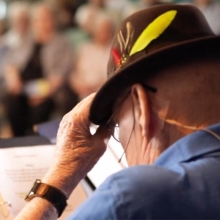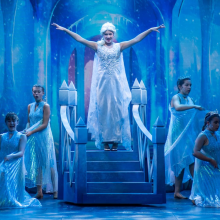Filichia Features: The Boy Friend Saved By a Girl Friend
Filichia Features: The Boy Friend Saved By a Girl Friend
 The show that was about to be presented was The Boy Friend, but what had happened 30 minutes before the performance turned the show into 42nd Street.
The show that was about to be presented was The Boy Friend, but what had happened 30 minutes before the performance turned the show into 42nd Street.
Here at Centenary College in Hackettstown, New Jersey, there’s a magnificent program for kids called the Centenary Young Performers Workshop. For two decades now, the program for teens and younger has been headed by Michael Blevins, who was a Broadway Baby in his time; he appeared in the original casts of The Tap Dance Kid, Bring Back Birdie and the 1982 revival of Little Me. If you missed Blevins in those, you can still see him perform, for he portrayed Mark in the film of A Chorus Line.
Each December, Blevins shows what he and the Centenary Young Performers Workshop can do. And if directing and choreographing one musical with children isn’t enough, Blevins takes on the responsibility of doing three -- which he then presents in rep. This year, his choices were The Boy Friend, A Chorus Line and Hello, Dolly!
But at the final run-through of The Boy Friend, Lilly Vaz, the girl who’d been entrusted to play Hortense the maid (who’d sing “It’s Nicer in Nice”), not only fell mid-number but also severely injured her ankle.
 Now what? Teen theater rarely has understudies or swings, and despite Blevins’ professionalism at most every turn, he doesn’t have official standbys. So Jenna Black, who was one of his assistant choreographers, had to serve.
Now what? Teen theater rarely has understudies or swings, and despite Blevins’ professionalism at most every turn, he doesn’t have official standbys. So Jenna Black, who was one of his assistant choreographers, had to serve.
And wouldn’t you know that The Boy Friend starts with Hortense on the phone filling us in on exposition in her heavy French accent? The young lady was so accomplished that I assumed I’d misunderstood who’d been injured; this girl had to be the one who’d been rehearsing this role for weeks. On the other hand, as we all know, when you get cast in a show, you not only wind up learning your own part, but everyone else’s too. So perhaps she was the emergency fill-in.
Not until early in Act Two did I know for sure, when Black came out to sing “It’s Nicer in Nice” and carried with her on stage a page which sported the lyrics. As it turned out, she only had it for insurance; her assurance was strong enough to carry her. Only occasionally did she refer to it, and soon she’d ended in triumph. The look of her face at song’s end was a mixture of amazement that she got through it, relief that it was over and – last and most certainly not least – joy that she was able to accomplish it.
The audience, which had been applauding and “whooing!” each number, gave an extra special burst of applause here. True, some of them were Centenary Young Performers who weren’t cast in this show, and others were plenty of parents. But sitting first row center was someone else applauding wildly: Lilly Vaz.
What a brave girl – on two different levels. Many a girl would have gone home and gone to bed, what with the pain in her ankle. How many others might not have been able to bear seeing another person do the role for which they had rehearsed for so long and so hard?
I was sitting in the row behind her and to the side, so I had an ample view of Vaz’s profile while Black was on stage doing “her” role. If she were devastated or jealous, I saw none of it. Although I can’t comment on what she would have been as a performer, I got the impression she’s quite a lady from the way she handled what may have been the most difficult moment in her entire life.
I must admit that I did have to laugh, albeit affectionately, at one aspect of the production. The Boy Friend begins with Maisie, Fay, Dulcie and Nancy singing how they’re “Perfect Young Ladies” at Madame Dubonnet’s Finishing School -- soon followed by their being joined by Polly to proclaim how much each has “got to have” and will “plot to have” the boy friend. The girls were, I’d estimate, ninth graders, and once they finished maintaining how they “dream about” and “scheme about” said boys, onto the stage bounded the boys -- who, I’d estimate, were mostly third-graders. To see the much more mature girls scream in delight at seeing the little boys they allegedly craved was inadvertently hilarious. (Well, the show is called The Boy Friend and not The Male Companion.)
I laughed even harder when one of these peanuts took the hand of a tall girl, kissed it, and then continued his kissing all the way up her arm – well, as far as his little head would allow him to go, anyway. All the girls squealed with pleasure at any attention the little lads were giving them, making them all the youngest cougars ever seen on stage.
Let’s give credit to one of The Boy Friend, one Alex Evans. He’s 18, which is twice the age of some lads who surrounded him. Many a young man in his position would have quit on the first day of rehearsals, for he would have felt that he was among babies. No: the play is apparently the thing with Evans, who knows that performing and gaining experience are the ultimate rewards.
Granted, in the other shows, Evans got to play mature roles -- Zach in A Chorus Line and Vandergelder in Dolly! But how many young men would have refused to be in an ensemble where he’d look like Tommy Tune in Munchkinland? Here’s betting that Evans’ professionalism and desire will serve him well in the future.
Of course, this brings up the now-and-forever bugaboo about getting boys to perform in musicals. Someone should make a poster with the pictures of professional athletes – in their prime, in their uniforms -- who have acted professionally, too. Let’s inform or remind kids that Michael Strahan, Joe Namath, Jim Brown, Alex Karras, Terry Bradshaw, Ed Marinaro, Merlin Olsen and Carl Weathers (we won’t include O.J. Simpson for obvious reasons) as well as Arnold Schwarzenegger all seized the opportunity to learn lines, rehearse and perform. If it’s good enough for Hall of Famers, it should be good enough for middle-school boys and young men in high school.
(And Blevins did ask his boys to be butch in one production number, demanding push-ups in time to music. See, we told you that musical theater was a healthy pastime. There’s also a number in which everyone must waltz, and Blevins taught his kids well. Think of it: they now have a skill that they can use for the rest of their lives at weddings and other such functions.)
Consider staging the show. It won’t be as taxing on your costume department as it might seem at first glance. Yes, it requires old-fashioned bathing suits for men, but those can be easily simulated by sleeveless T-shirts. The third act offers a costume ball, so all you have to do is go to the costume shop and take one of everything off the rack and fit everyone as well as possible. No matter what outfit you choose, you can’t go wrong.
Of course, Sandy Wilson wrote The Boy Friend as a valentine to ‘20s musicals, but that doesn’t mean that the show doesn’t carry an important message for kids. The story centers on Polly (the excellent Erin Martire), a rich young woman who needs to be loved for herself and not her money. She falls for Tony, a mere delivery boy (the accomplished Raphael Pelczmann), but as it turns out, he needs to be loved for himself, too; that’s why each pretends to be impoverished. The idea of being accepted for who you are and not for any other reason is a lesson every kid should learn.
And all these kids in Hackettstown now have learned Latin expression sine qua non, for it shows up in the title song. For those who have forgotten, sine qua non means “an indispensable and essential action, condition, or ingredient.” Michael Blevins and the Centenary Young Performers Workshop have long proved that they are sine qua non to the artistic and cultural health of western New Jersey.
 You may e-mail Peter at pfilichia@aol.com. Check out his weekly column each Tuesday at www.masterworksbroadway.com and each Friday at www.kritzerland.com. His upcoming book, Strippers, Showgirls, and Sharks – a Very Opinionated History of the Broadway Musicals That Did Not Win the Tony Award is now available for pre-order at www.amazon.com.
You may e-mail Peter at pfilichia@aol.com. Check out his weekly column each Tuesday at www.masterworksbroadway.com and each Friday at www.kritzerland.com. His upcoming book, Strippers, Showgirls, and Sharks – a Very Opinionated History of the Broadway Musicals That Did Not Win the Tony Award is now available for pre-order at www.amazon.com.

























